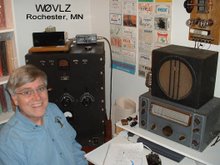As ham radio approached January 1, 1929, and the m
 ore rigorous standards, the ARRL encouraged hams to improve their stations. One improved transmitter design was a single tube Hartley oscillator described by Ross Hull in the August 1928 issue of QST. Bruce Howes, W1UJR, covers this design on his web site here.
ore rigorous standards, the ARRL encouraged hams to improve their stations. One improved transmitter design was a single tube Hartley oscillator described by Ross Hull in the August 1928 issue of QST. Bruce Howes, W1UJR, covers this design on his web site here.
I've been searching through my junque box looking for the parts I need. The first step was a parts list and an enlarged scan/photo of the transmitter. After picking thr
 ough multiple boxes and peanut butter jars I've lots of possibilities. Now it's a matter of sorting through what I have for the parts that match the original design.
ough multiple boxes and peanut butter jars I've lots of possibilities. Now it's a matter of sorting through what I have for the parts that match the original design.





